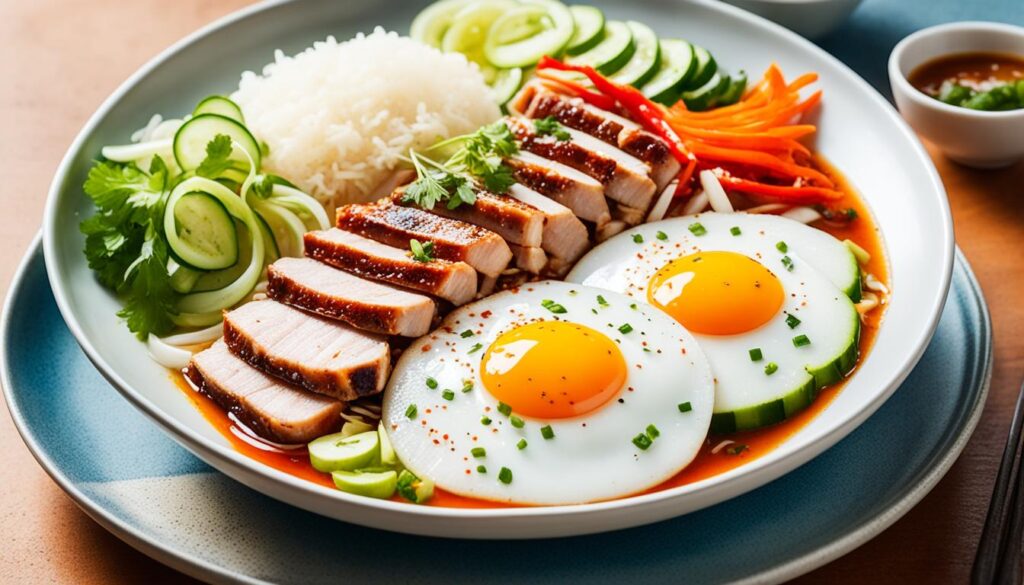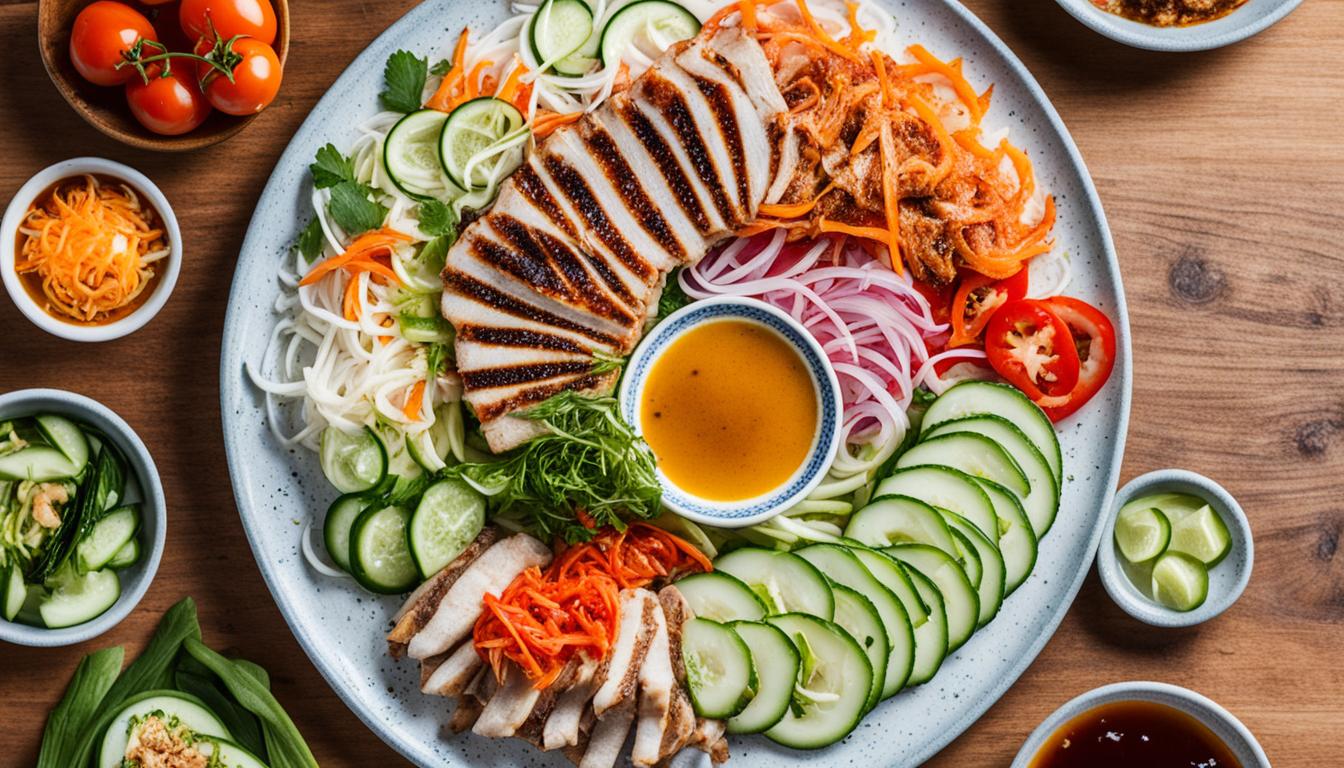Did you know that over 50 million Vietnamese people enjoy the beloved dish of com tam, or Vietnamese broken rice, every single day? This cornerstone of Vietnamese cuisine is a true culinary treasure, featuring savory grilled pork, shredded chicken, pickled veggies, and the perfect nuoc cham dipping sauce. In our authentic recipe, we’ll show you how to recreate the flavors of this iconic Saigon street food at home.
Broken rice, known as “com tam” in Vietnamese, refers to the smaller rice grains that break apart during the milling process. While these grains were once seen as less desirable, they are now highly prized for their ability to soak up flavors and their unique texture. Our com tam recipe includes instructions for cooking the broken rice on the stovetop and in a rice cooker, as well as details on the key components that make up a traditional com tam plate.
Introduction to Com Tam: Vietnam’s Iconic Broken Rice Dish
Com tam, or Vietnamese broken rice, is a beloved dish that is a cornerstone of Vietnamese cuisine. The term “com tam” refers to the broken rice grains that are the result of the milling process. Broken rice was originally seen as less desirable than whole grains, and was often consumed by the poorest people in Vietnam’s rural Mekong Delta region. However, as people from the Mekong Delta moved to Saigon (now Ho Chi Minh City) after 1975, they introduced broken rice to the city and it has since become one of the most iconic foods of southern Vietnam.
What is Com Tam?
Com tam, or Vietnamese broken rice, is a staple Asian rice dish that is deeply rooted in Vietnamese cuisine. The dish is characterized by the use of smaller, broken rice grains that have a unique texture and ability to absorb flavors.
The History and Significance of Broken Rice in Vietnamese Cuisine
Broken rice, known as com tam in Vietnamese, was initially seen as a less desirable byproduct of the rice milling process. However, over time, this humble ingredient has become a beloved and iconic part of Vietnamese cuisine, particularly in the Saigon street food scene. The story of com tam’s rise to prominence is a testament to the ingenuity and resilience of the Vietnamese people.
com tam vietnamese broken rice recipe
To create the perfect
com tam
, or Vietnamese broken rice dish, at home, you’ll need a few key ingredients and preparation steps. Let’s dive in!
Ingredients and Preparation
The foundation of com tam is, of course, the broken rice itself. Seek out high-quality brands like Three Ladies or Parrot for the best texture and flavor. Before cooking, be sure to rinse the rice grains several times until the water runs clear – this helps remove any excess starch for fluffier, less sticky rice.
Cooking Instructions for Stovetop and Rice Cooker
You can prepare the com tam rice on the stovetop or in a rice cooker, using a 1:1 ratio of rice to water. For the stovetop method, bring the rice and water to a boil, then reduce heat and simmer, covered, for about 15-20 minutes until the rice is tender and fluffy. In a rice cooker, simply add the rice and water, press the cook button, and let the machine do its magic.
Tips for Perfect Fluffy Broken Rice
To ensure your com tam rice turns out perfectly fluffy and separated, be sure to rinse the rice well before cooking. This helps remove excess surface starch. You can also try soaking the rice in water for 30 minutes to an hour before cooking, which can further enhance the texture. Finally, avoid overcrowding the pot or rice cooker, as this can lead to clumping.

Authentic Com Tam Toppings and Accompaniments
When enjoying an authentic com tam dish, the broken rice is just the foundation. The true essence of this beloved Vietnamese specialty lies in the delectable toppings and accompaniments that complement the rice. Let’s explore the key components that make up a traditional com tam plate.
Com Suon: Grilled Pork Chop
No com tam dish is complete without the iconic grilled pork chop, known as com suon. These succulent pork chops are marinated in a savory blend of fish sauce, sugar, garlic, and spices, then grilled to perfection, resulting in a caramelized exterior and juicy interior that pairs beautifully with the broken rice.
Bi: Shredded Pork Skin and Pork Floss
Another essential topping for com tam is bi, a combination of shredded pork skin and pork floss. The crispy, airy pork skin and fluffy, fibrous pork floss add a delightful textural contrast to the dish, while their savory flavors complement the other components perfectly.
Cha Trung Hap: Vietnamese Meatloaf
Cha trung hap, a Vietnamese-style meatloaf made with ground pork, eggs, and aromatic herbs and spices, is a classic com tam topping that brings a soft, tender element to the dish. The savory flavors of the meatloaf blend seamlessly with the broken rice and other accompaniments.
Pickled Vegetables and Nuoc Cham Dipping Sauce
To balance the richness of the pork toppings, com tam is often served with a selection of pickled vegetables, such as carrots, daikon, and cucumber. These crunchy, tangy pickles provide a refreshing counterpoint to the dish. Additionally, a flavorful nuoc cham dipping sauce, made with fish sauce, lime juice, sugar, and chilies, is essential for drizzling over the com tam and adding a burst of umami and tanginess.
